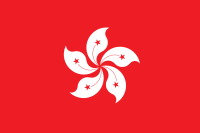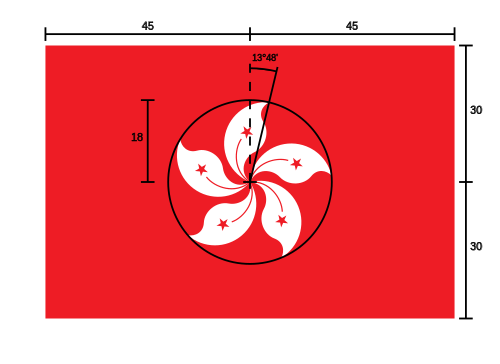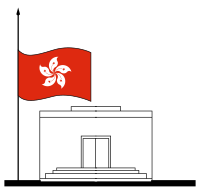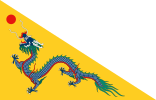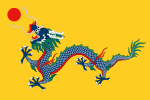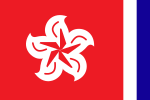
Hong Kong is a special administrative region of the People's Republic of China. With 7.4 million residents of various nationalities in a 1,104-square-kilometre (426 sq mi) territory, Hong Kong is one of the most densely populated territories in the world.

The Basic Law of the Hong Kong Special Administrative Region of the People's Republic of China is a national law of China that serves as the organic law for the Hong Kong Special Administrative Region (HKSAR). Comprising nine chapters, 160 articles and three annexes, the Basic Law was composed to implement Annex I of the 1984 Sino-British Joint Declaration.

The national flag of the Republic of Korea, also known as the Taegeukgi, has three parts: a white rectangular background, a red and blue taegeuk in its center, accompanied by four black trigrams, one in each corner. Flags similar to the current Taegeukgi were used as the national flag of Korea by the Joseon dynasty, the Korean Empire, as well as the Korean government-in-exile during Japanese rule. South Korea adopted the Taegeukgi for its national flag when it gained independence from Japan on 15 August 1945.
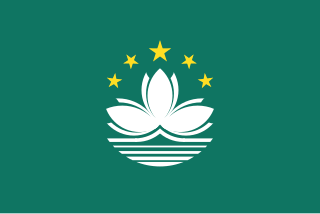
The Regional Flag of the Macau Special Administrative Region of the People's Republic of China is light green with a lotus flower above the stylised Governador Nobre de Carvalho Bridge and water in white, beneath a circular arc of five golden five-pointed stars: one large star in the center of the arc with two smaller stars on each side of the large star, each with a point angled directly outward from the center of the common circle on which they lie.
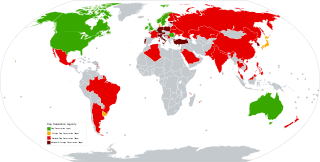
Flag desecration is the desecration of a flag, violation of flag protocol, or various acts that intentionally destroy, damage, or mutilate a flag in public. In the case of a national flag, such action is often intended to make a political point against a country or its policies. Some countries have laws forbidding methods of destruction or forbidding particular uses ; such laws may distinguish between the desecration of the country's own national flag and the desecration of flags of other countries. Some countries have also banned the desecration of all types of flags from inside the country to other country flags.

Bauhinia × blakeana, commonly called the Hong Kong orchid tree, is a hybrid leguminous tree of the genus Bauhinia. It has large thick leaves and striking purplish red flowers. The fragrant, orchid-like flowers are usually 10 to 15 centimetres across, and bloom from early November to the end of March. Although now cultivated in many areas, it originated in Hong Kong in 1880 and apparently all of the cultivated trees derive from one cultivated at the Hong Kong Botanical Gardens and widely planted in Hong Kong starting in 1914. It is referred to as bauhinia in non-scientific literature though this is the name of the genus. It is sometimes called the Hong Kong orchid. In Hong Kong, it is most commonly referred to by its Chinese name of 洋紫荊 (yèuhng jígīng).

Tao Ho was a Hong Kong architect best known for designing the Bauhinia emblem on the flag of Hong Kong.

The Regional Emblem of the Hong Kong Special Administrative Region of the People's Republic of China came into use on 1 July 1997, after the handover of Hong Kong from the United Kingdom to the People's Republic of China.

The Golden Bauhinia Square is an open area in Wan Chai, Hong Kong. The square was named after the giant statue of a golden Bauhinia blakeana at the centre of the area, situated outside the Hong Kong Convention and Exhibition Centre, where the ceremonies for the handover of Hong Kong and the establishment of the Hong Kong Special Administrative Region were held in July 1997. A flag-raising ceremony is held every day at 8:00 am. It is considered a tourist attraction.

The handover of Hong Kong from the United Kingdom to the People's Republic of China was at midnight on 1 July 1997. This event ended 156 years of British rule in the former colony, which began in 1841. Hong Kong was established as a special administrative region of China (SAR) for 50 years, maintaining its own economic and governing systems from those of mainland China during this time, although influence from the central government in Beijing increased after the passing of the Hong Kong national security law in 2020.

The Urban Council (UrbCo) was a municipal council in Hong Kong responsible for municipal services on Hong Kong Island and in Kowloon. These services were provided by the council's executive arm, the Urban Services Department. Later, the equivalent body for the New Territories was the Regional Council.

Chan Kin-por, GBS, JP is a member of the Legislative Council of Hong Kong. He became chairman of the Legco Finance Committee in 2015. He has been appointed as Executive Council Member in 2022.
This is a list of bills that were introduced and passed into law and became ordinances of the territory by the Provisional Legislative Council that sat for a year from July 1997 to 1998.Laws passed before 1 July 1997 were passed by the provisional legislature that sat while the outgoing legislature was still sitting. They were not in effect until the provisional legislature started its officially sittings and took over as the legislature of the territory on 1 July 1997.

The national flag of the People's Republic of China, also known as the Five-star Red Flag, is a Chinese red field with five golden stars charged at the canton. The design features one large star, with four smaller stars in an arc set off towards the fly. It has been the national flag of China since the foundation of the People's Republic of China on 1 October 1949. The flag was designed by Zeng Liansong.

The Constitutional and Mainland Affairs Bureau is a ministerial-level policy bureaux of the Government of Hong Kong responsible for the implementation of the Basic Law, including electoral matters and promotion of equal opportunities and privacy protection. The bureau also functions as the intermediary between the HKSAR Government and the Central People's Government and other Mainland authorities under the principles of "One Country, Two Systems", including the coordination of liaison between the HKSAR Government and Central authorities, promoting regional co-operation initiatives between Hong Kong and the Mainland, and overseeing the operation of offices of the HKSAR Government on the Mainland.
Throughout the history of Hong Kong as a colony, dependent territory or occupied territory, it has had its own flag in almost all periods, but it has never had its own official national anthem nor regional anthem. Instead, the anthem of the ruling sovereign state has always been adopted for use in an official capacity and played on occasions such as major sporting events or ceremonies. However, a number of popular anthems have been adopted by segments of the population as representative anthems, and are listed under the "unofficial national anthems" section below.

Chiayi City Government is the municipal government of Chiayi City, Taiwan Province, Republic of China.
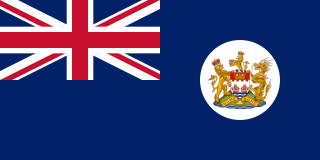
The flag of Hong Kong from 1871 to 1997 was a Blue Ensign with the coat of arms of Hong Kong on a white disk. In Hong Kong, it is also nicknamed the Hong Kong flag (香港旗), British Hong Kong flag (英屬香港旗) or the Dragon and Lion flag (龍獅旗). In 1959, following a grant from the College of Arms and with the consent of Queen Elizabeth II, it was adopted as the flag of British Hong Kong. While the flag lost its official status following the 1 July 1997 transfer of sovereignty over Hong Kong, it resurfaced in the 2010s as a symbol of support for Hong Kong autonomy and protest against Chinese interference in Hong Kong.

The flag of Weihaiwei was the flag used by the British leased territory of Weihaiwei during British rule between 1903 and 1930. The flag consisted of a British blue ensign with an emblem containing a pair of Mandarin ducks.

The Black Bauhinia flag is a variant of the flag of Hong Kong with a black background and a modified bauhinia flower. The flag gained popularity during the 2019–2020 Hong Kong protests and is often displayed by pro-democracy protesters.
